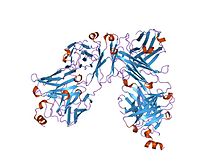CD20-like family
| CD20-like family | |||||||||
|---|---|---|---|---|---|---|---|---|---|
 crystal structure of rituximab fab in complex with an epitope peptide | |||||||||
| Identifiers | |||||||||
| Symbol | CD20 | ||||||||
| Pfam | PF04103 | ||||||||
| Pfam clan | CL0347 | ||||||||
| InterPro | IPR007237 | ||||||||
| TCDB | 1.A.37 | ||||||||
| |||||||||
In molecular biology, the CD20-like family of proteins includes the CD20 protein and the beta subunit of the high affinity receptor for IgE Fc, MS4A2. MS4A2 has a tetrameric structure consisting of a single IgE-binding alpha subunit, a single beta subunit, and two disulfide-linked gamma subunits. It has four putative transmembrane segments and a probable topology where both amino- and carboxy termini protrude into the cytoplasm.[1] This family also includes LR8 like proteins from humans (TMEM176B), mice and rats. The function of the human LR8 protein is unknown although it is known to be strongly expressed in the lung fibroblasts.[2] This family also includes sarcospan, a transmembrane component of dystrophin-associated glycoprotein. Loss of the sarcoglycan complex and sarcospan alone is sufficient to cause muscular dystrophy. The role of the sarcoglycan complex and sarcospan is thought to be to strengthen the dystrophin axis connecting the basement membrane with the cytoskeleton.[3]
References
- ^ Hupp K, Siwarski D, Mock BA, Kinet JP (December 1989). "Gene mapping of the three subunits of the high affinity FcR for IgE to mouse chromosomes 1 and 19". J. Immunol. 143 (11): 3787–91. doi:10.4049/jimmunol.143.11.3787. PMID 2531187. S2CID 9813446.
- ^ Lurton J, Rose TM, Raghu G, Narayanan AS (February 1999). "Isolation of a gene product expressed by a subpopulation of human lung fibroblasts by differential display". Am. J. Respir. Cell Mol. Biol. 20 (2): 327–31. CiteSeerX 10.1.1.326.2708. doi:10.1165/ajrcmb.20.2.3368. PMID 9922225.
- ^ Araishi K, Sasaoka T, Imamura M, Noguchi S, Hama H, Wakabayashi E, Yoshida M, Hori T, Ozawa E (September 1999). "Loss of the sarcoglycan complex and sarcospan leads to muscular dystrophy in beta-sarcoglycan-deficient mice". Hum. Mol. Genet. 8 (9): 1589–98. doi:10.1093/hmg/8.9.1589. PMID 10441321.
